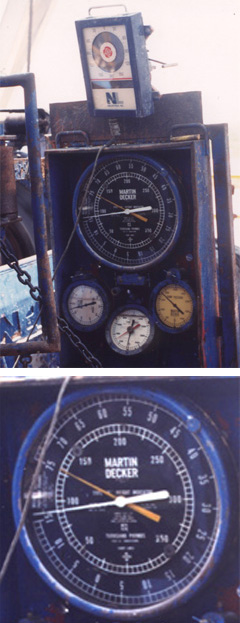1. n. [Drilling]
One of the instruments that the driller uses to monitor and improve the operating efficiencies of the drilling operation. The actual measurement of weight is made with a hydraulic gauge attached to the dead line of the drilling line. As tension increases in the drilling line, more hydraulic fluid is forced through the instrument, turning the hands of the indicator. The weight that is measured includes everything exerting tension on the wire rope, including the traveling blocks and cable itself. Hence, to have an accurate weight measurement of the drillstring, the driller must first make a zero offset adjustment to account for the traveling blocks and items other than the drillstring. Then the indicated weight will represent the drillstring (drillpipe and bottomhole assembly). However, the driller is only nominally interested in this weight for most operations. The weight of interest is the weight applied to the bit on the bottom of the hole. The driller could simply take the rotating and hanging off bottom weight, say 300,000 pounds [136,200 kg], and subtract from that the amount of rotating on bottom weight, say 250,000 pounds [113,500 kg], to get a bit weight of 50,000 pounds [22,700 kg]. However, most rigs are equipped with a weight indicator that has a second indicator dial that can be set to read zero ("zeroed") with the drillstring hanging free, and works backwards from the main indicator dial. After proper zeroing, any weight set on bottom (that takes weight away from the main dial), has the effect of adding weight to this secondary dial, so that the driller can read weight on bit directly from the dial.
See related terms: drill collar, traveling block

2. n. [Well Workover and Intervention]
A device or system used to measure, display and record the weight of a tubing string, slickline string or coiled tubing string in the wellbore. The weight indicator is the principal means by which the equipment operator monitors the function of downhole tools and equipment. Factors such as fluid density, which affects buoyancy and wellhead pressure, also impact the forces measured at surface. These factors can influence the apparent string weight significantly.